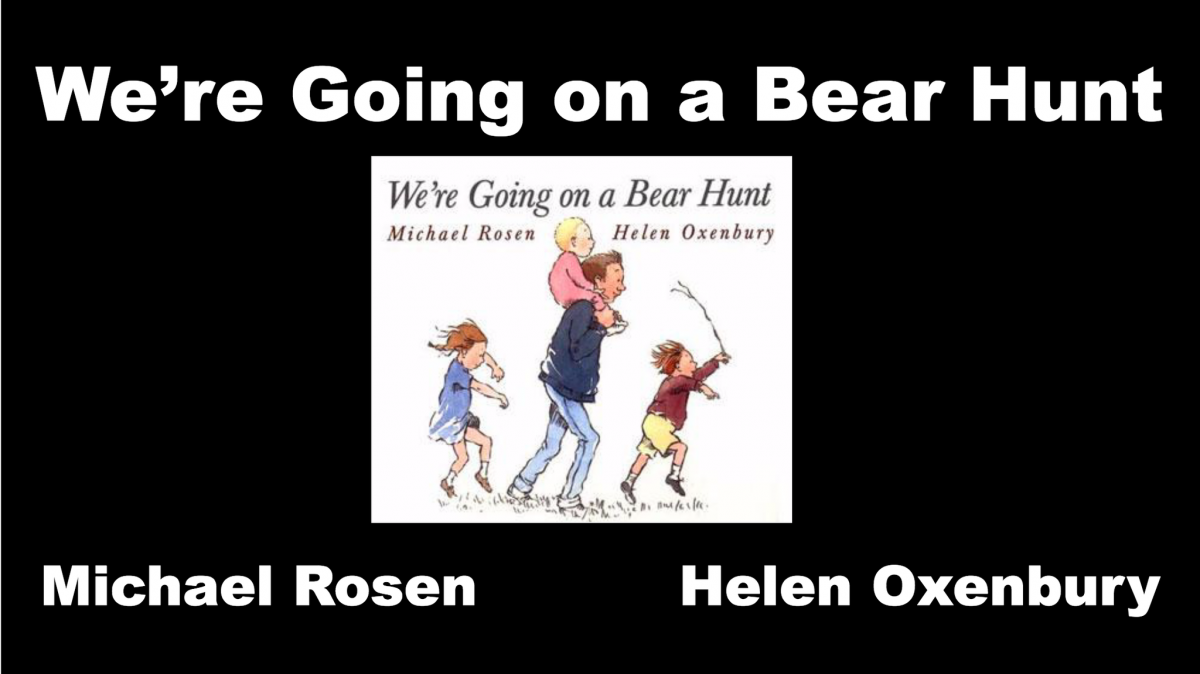As part of the graduate coursework for Visual Impairments and Multiple Disabilities in the Teacher Preparation Program in Visual Impairments at the University of Kentucky, students were asked to complete four projects: Story Box, Picture Communication Symbols for Story Box, Tactile Communication Symbols, and Talking Book Project.
We are sharing them on Paths to Literacy and hope that others will use them! Please add your comments at the bottom of the page.
Story Box
This project is based on the book We’re Going on a Bear Hunt by Helen Oxenbury and Michael Rosen.
Items included in story bag are:
- 1 bear
- 1 bag of grass
- 1 bottle of water
- 1 container of “mud” (kinetic sand)
- 1 bag of sticks
- 1 bag of snow
- 3 rocks
- 2 googly eyes
- 2 pom poms
- 1 door knob
- 1 piece of fabric
Each item was for the story bag to closely represent the real object. Although, so items were not actual items. Students will be required to have knowledge about bears. About their size and features so that they understand that the stuffed bear is not a representation of the actual animal itself. The grass is artificial grass, but very closely represents actual grass that no discussion will be required other than discussing possibly the different types of grass. The water that represents the river is accurate to demonstrate the feeling, just not the flowing. The kinetic sand has a “mud like” texture. I chose the kinetic sand rather than the actual mud for cleanliness. The sand is cleaner in the classroom and will not get students hands and clothing dirty, yet still has a texture as that of mud might. The sticks are limbs from a tree that introduces students to the actual sticks in nature. A discussion about different sizes of trees will be beneficial. The bag of snow is artificial. Its texture is similar to that of real snow as it is lightweight. Students will need to know that snow is usually very cold. The rocks represent the cave. Students will need to understand the location of caves, the temperature in caves, and the moisture and dampness within a cave, to fully understand what a cave is. For this activity students are introduced to a cave being created by rock. The two googly eyes may be difficult for students to understand. This object will require lots of introducing. Mainly these items are round and small as two eyes might be. Explaining to students that the googly eyes have to two smaller black circles within the larger white one that moves around represents the eyes pupils. The noise that the googly eyes make will help students recognize them when they shake them. The two pom poms that represent the two fuzzy ears are much smaller than those of bears, students will require this background knowledge. The door knob is an actual knob that students can become familiar with. The piece of fabric represents that of a cover from the bed. Students will not require much prior knowledge for the fabric.
Implementing this into instruction will depend on each individual child. This could be used in multiple science lessons. This story applies to rocks, plants, animals, trees, weather, natural formations, structure of a home, specifically doors, stairs, and furniture. The structure of homes, furniture, and stairs builds the foundation for younger children learning the layout of different homes or different environments other than their own.
Picture Communication Symbols for Story Box
- Bear: to represent the character in the story
- Grass: to represent the long, wavy grass they must travel through
- Girl crossing the river: to represent them wading across the river
- Mud: to represent the mud they must cross
- Trees: to represent the woods they travel through
- The snow storm: to represent the snow storm the characters go through
- Cave: to represent the location of the bear
- The nose: to represent the shiny wet nose they see in the cave
- Googly eyes: represent the two eyes they find in the cave
- The bear head with large ears: to represent the two ears the see in the cave
- Door: to represent the door on their house as they try to escape the bear
- Bed: to represent where they hide once they get inside the house
For my board maker symbols I used a variety of contrasts with bold print on each. I also used multiple borders for them that would allow the print and picture to stand out. The first symbol, the bear shows up well on the yellow background, since the bear is a dark color it provides the contrast needed for a low vision student. The second symbol, the grass, has the bold border with a red background. The red makes the green grass show up well. The next symbol, crossing the river, was placed on a yellow background with a long dash-short dash border. I left the next symbol on a white background using a solid bold border. The white made the mud symbol easier to view. The forest symbol is also on a yellow background. This makes the green in the trees more vivid. The Snowstorm is on a red back ground. Since the snow is white, the red background makes it easier to view. Same with the cave symbol, as well as the nose and the bed. The googly eyes are two single eyes on a yellow background. The bear ears on white. And finally the door on yellow.
Tactile Communication Symbols
Questions
- What character are they hunting in this story?
- What is long and wavy that they family must go through?
- What is deep and cold?
- What do they go through that is thick and oozy?
- The family must go through a big, dark ______________.
- Next, they go through a narrow, gloomy __________________.
- Finally they find _____ furry ears.
- The also see _____ googly eyes.
- They become ___________ and run back home through their ___________.
- They quickly run up the stairs and jump into ____________.
This activity will be a re-telling of the story activity. Students will use the tactile cards to answer the comprehension questions and re-tell the story. Students will be required to list the events in the order that they took place in the story.
Each symbol was chose to represent the parts of the story. Some items are the same as the larger items included in the story bag, so students will not require prior knowledge for those. However, the bear is much smaller and very different.
Students will have to feel for the outline of the bear with additional guidance to describe what they are feeling. Students will have to have repetitive practice at recognizing that this symbol represents a bear. The snow flake will also require instruction. The door knob is similar to that of a real door knob, it’s just smaller. Students will need to be aware that knobs are a variety of shapes and sizes, but door knobs for house doors are generally much larger.
 This activity can be implemented into instruction in reading classes as well as across the ECC. Reading/listening comprehension and sequencing is a huge part of this activity. Students must listen to specific details, listening for specific recall of the number of eyes and ears. One question require higher order thinking for young students when they have to infer the emotion of the family as they escape the bear. Students becoming familiar with a variety of items in their environment and how they may represent larger items is an important life skill for students with visual impairments.
This activity can be implemented into instruction in reading classes as well as across the ECC. Reading/listening comprehension and sequencing is a huge part of this activity. Students must listen to specific details, listening for specific recall of the number of eyes and ears. One question require higher order thinking for young students when they have to infer the emotion of the family as they escape the bear. Students becoming familiar with a variety of items in their environment and how they may represent larger items is an important life skill for students with visual impairments.





